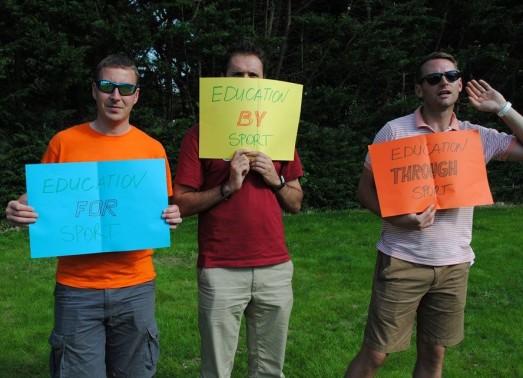MOVE&Learn manual “splendid source of inspiration” for education through sport trainers
10/09/2014

Interview with Sorin Buruiana (centre of photo), ETSMoveandLearn community
As a result of an EU-funded multi-measure youth project, Training of Trainers (ToT), ISCA developed and launched the MOVE&Learn manual on education though sport for young people in 2013. This interactive manual has given rise to a whole new community of young people who are using and promoting this method of non-formal education across Europe. This community is called the ETSMoveandLearn community.
ISCA talked to Sorin Buruiana, who was working with ISCA when the MOVE&Learn manual was conceived and who is now a fundraising consultant and an independent trainer, on how he sees the value of the manual and how it is being taken up beyond its founding project.
Q. What is the ETSMoveandLearn community and what is your role in it?
A. The ETSMoveandLearn community is a platform for people who are using the “education through sport” approach in their activities. We call them “ETS practitioners” and their usual profile is trainer, facilitator, youth worker, project manager or sport coach. I would call myself a developer of this community, because we are functioning at this point on a peer-to-peer basis, with no formal hierarchy. We create opportunities for each other and for organisations who would like to be involved in growing the community by organising projects, consequently applying for funding, doing training courses, seminars and teaching others how to use the ETS approach properly.
Q. How do you use the MOVE&Learn manual in your non-formal training of trainers, youth leaders and coaches in grassroots sport?
A. The Move&Learn manual is a splendid source of inspiration for any trainer, facilitator or sport coach. It explains the concrete methodology, what ETS is and what is not (which means distinguishing it from “education FOR sport” and “education BY sport”), and offers concrete educational activities, explained step-by-step. Many community members are using it for their events. I am also using it to raise awareness that non-formal education is rather static at this point in time, as it is implemented by many organisations and institutions. There is too much brain activity and the body is ignored. This can have negative results, especially in a one-week training course.
I have organised workshops for several international organisations using ETS and I have received very positive feedback. To give you an example, in August I was involved in a 3-week Training of Trainers Advanced programme, organised by MS ActionAid Denmark in Copenhagen, for highly experienced trainers from all over the world. I facilitated a half-day session on ETS, and at the end of the day one trainer confessed that she felt like a new (training) world had opened up in front of her.
Q. Do you find it a valuable tool?
A. I don’t just find it a valuable tool, I think it should not be missing from the toolbox of any experienced trainer. If one should claim that learning is holistic, using our body while we are learning is a vital part of that statement. I don’t know a more effective approach than ETS.
Q. What potential do you see for the tool to be used by other organisations or groups?
A. ETS is easy to integrate in almost any kind of training. But a trainer should think creatively, and I think most of us get stuck in old training patterns after some years of experience. In the training that I mentioned before, I took one activity that was used by one of my colleagues, kept all the learning objectives and steps, and integrated physical activity into it. This showed the group how training sessions could be done in another way.
The potential I see is huge – I am talking about creating a richer experience for the participants, by addressing their needs better and using diverse methods, not only the classic presentations, plenary and group discussions.
Q. Can you tell us about any upcoming training courses that are using this approach?
A. There are a few activities confirmed, which are being organised by the community members. The Association for Dialogue, Culture and Sport will implement “ETSPromo” in Romania, in October, to promote the ETS approach and Move&Learn manual to practitioners from 11 countries. The Bulgarian sports development association will organise “Sport values for better Europe”, in November. Next year we will resume a long-term programme on international project management called YesWeRun. And much more.
Instead of listing them all, I will just recommend to any person who is interested in finding out more to check the community page on Facebook or the Twitter account ETSMoveandLearn and the online learning platform MOVE & Learn
Posted on 10/09/2014 by

